Imagine if you could see an immediate boost in your local website rankings, from just one minor change made to your site?
There’s a ridiculously simple way to increase your website’s local rankings and website traffic, instantly.
…whether you run a small flower shop, or plumbing business, or a multi-office real estate company, you’ll love this guide.
We’re going to share with you 17 practical strategies for improving your local SEO website rankings TODAY.
…whilst generating you more prospects and customers to your business.
Exclusive Blog Post Bonus: Click Here to Download to a free bonus checklist that will show you how to get your local business onto the first page.
Here they are:

1. Create or Claim Your Google Business Page
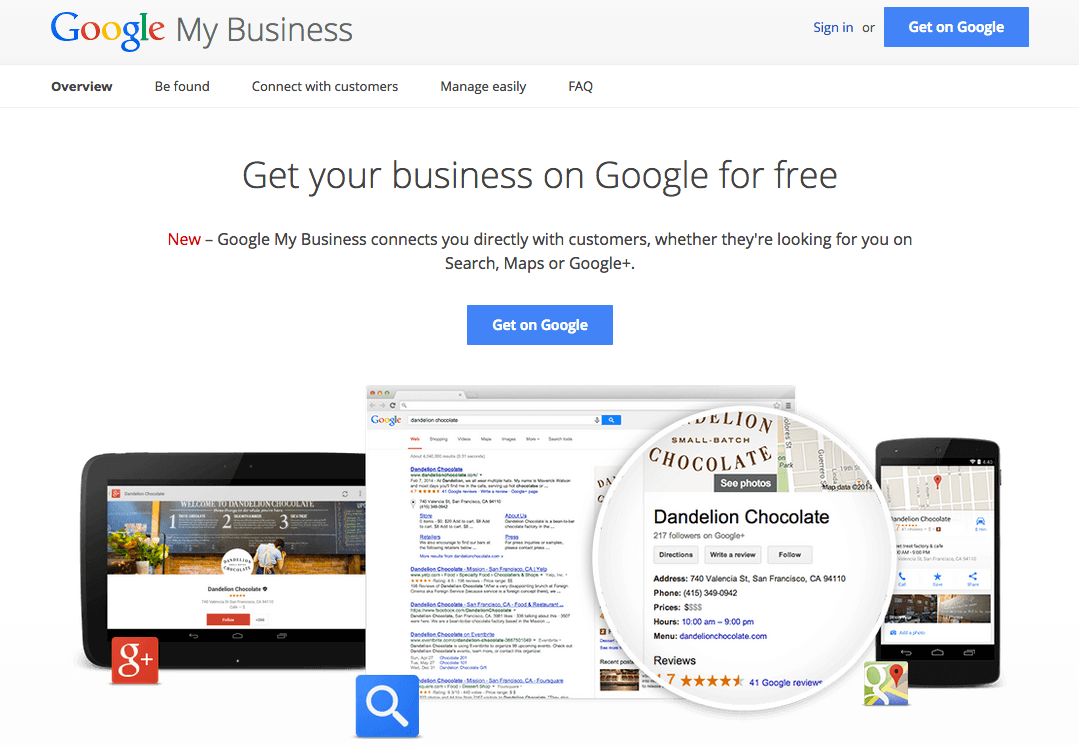
Your Google business page (also known as your Google Places for Business page) is an underutilised tool for local businesses – but is key to success in Google’s local search results.
Here you can update and control business information, respond to customer reviews and upload media.
All of this is visible on Google search results and builds credibility for your business.
- Create or claim your Google business page
- Update it with your most recent business details
- Add a description on the services and products your business offers
- Add your website link
- Wait for your verification postcard (approximately 2 weeks)
ACTION STEP: Use Google My Business to claim and update your Google business page.
2. Get Some Customer Reviews on Your Google Page
Everyone knows that business reviews are crucial in the consumer decision making and the overall purchasing process.
If a customer has a positive experience, encourage them to leave a review on your Google business page.
5 reviews will get you a ‘star rating’ next to your business name in the search results.
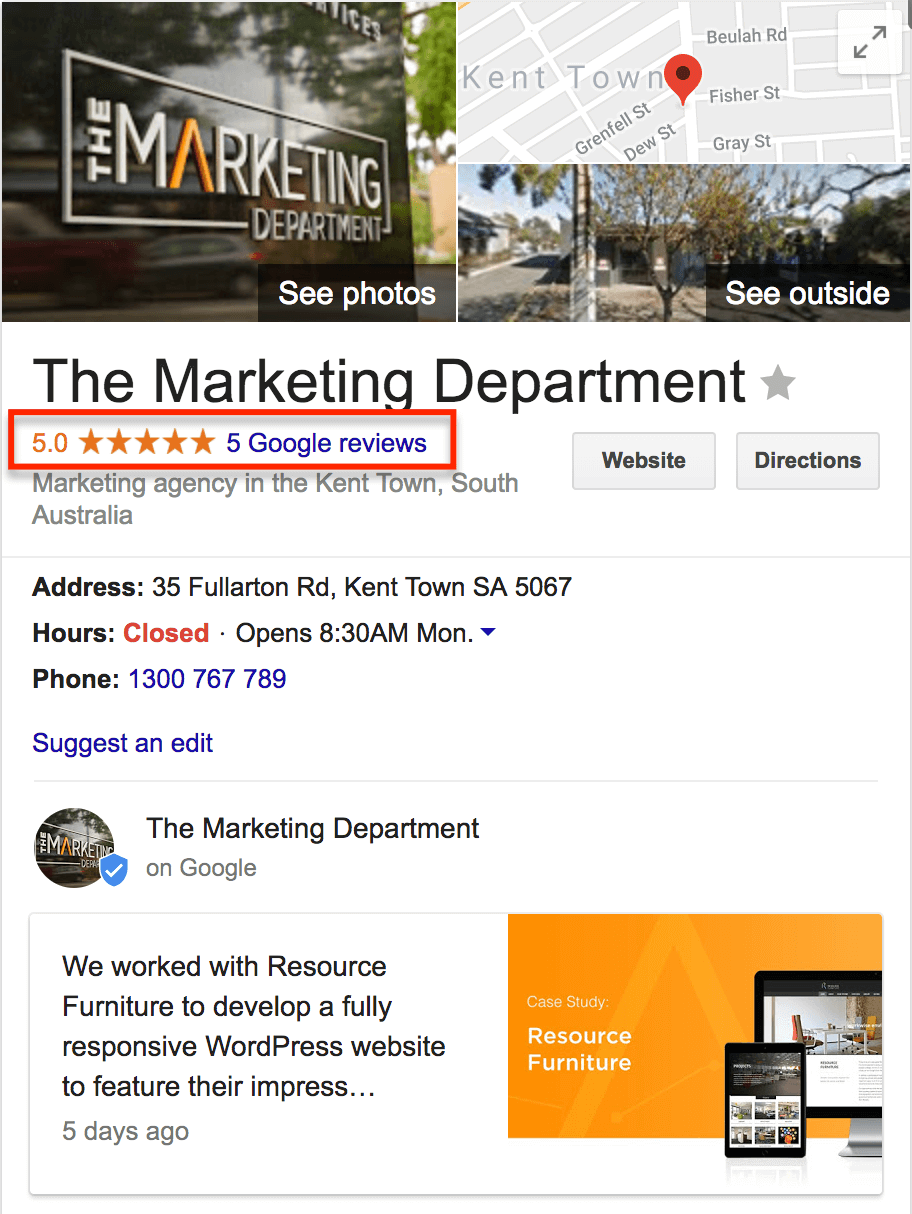
The quantity and quality of third party review websites will also have a major impact on your rankings in your local area, so encourage your customers to leave reviews there also.
You can do this by:
- Emailing or calling existing happy customers and ask them to leave a review
- Contacting friends or family members who might have used your services and ask them to leave a review.
- Publishing a ‘review us’ page on your website that links to the relevant review websites.
ACTION STEP: Call or email your customers and ask for a review on your Google page.
3. Update and Create More Citations
Citations are at the core of any local search campaign – and the more, the merrier.
They are ‘mentions of your business name, address, website and phone number on the Internet’.
Citations are the foundation of how Google interprets and classifies your business information. It is crucial to ensure these citations are consistent.
This means that your Business name, Address and Phone number should appear exactly the same on every website.
So check social media profiles, business directory listings and your own website to make sure they are all the same.
ACTION STEP: Head over to Whitespark or and get them to update and build additional citations for your business OR do it yourself!
4. Create Some Content
A simple formula to remember: more content = more search traffic.
Content that is quality, comprehensive and engaging can substantially increase your traffic and overall conversions coming from your website.
Content comes in many forms including:
- Blog posts
- Videos
- Podcasts
- Screencasts
- Slideshows
- Interviews
- Reviews
- Whitepapers
You should also review the existing content on your website to make sure it is easy to understand, informative and includes some variations of your targeted keywords within the content.
If you’re having trouble producing some content, record yourself talking into a microphone, and then get that transcribed using a Fiverr service – then use this transcription as the foundation of a blog post.
It’s far easier to talk about a topic for 10 minutes than it is sitting down and trying to write a blog post for 3 hours.
Once the audio is transcribed, the next step is to edit the transcription, add in some headlines and formatting, and publish it as a blog post!
ACTION STEP: Buy a Blue Yetti and use it to create a podcast, audio recording, video, and then turn the transcription of your audio file into a blog post.
5. Get a Responsive Mobile Friendly Website
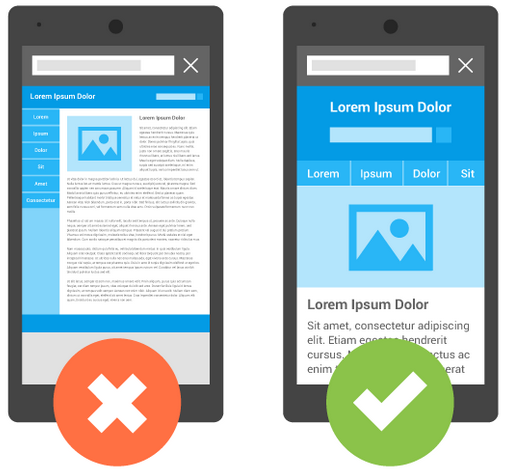
As a local business, a large share of your visitors will be searching Google for your products and services from a combination of mobiles and tablet devices.
These mobile devices can now tell if a website is mobile-friendly directly within Google’s search results
If you don’t have a responsive websites that automatically resizes based on the browser and device you customers are using, then you are behind your competition, and you’ll start to drop down the rankings.
ACTION STEP: Make your website responsive.
6. Show Your Expertise (And Give Your Customers What They Want)
It seems simple, but you really have to give your customers what they want!
Your prospects might want advice on how to save money on your products or services, or identify other ways to use or maintain them.
It’s your job to demonstrate your knowledge and expertise, and provide top quality information to your prospects and build your company’s reputation as the ‘go to guys’ for any information in your local space.
Consider including videos, podcasts, slideshows, guides and updates on your industry.
The better your information, the easier it is to generate more website traffic, and better qualify your customers.
Blogging and sharing information can be a powerful marketing technique with multiple benefits including:
- Encouraging shares on social media (increasing your reach)
- Attracting backlinks
- Attracting a more interactive audience
- Building your email subscription base
- Demonstrating your industry expertise
Blogging doesn’t have to be a time consuming endeavour – but it does require some initial planning, creative thinking and a consistent calendar that works for you.
ACTION STEP: Check out what your competitor’s are writing about, and create better posts based on those that receive the most social shares.
7. Get Some Backlinks To Your Website
Relevant and quality backlinks from authority websites are the difference between whether your website ranks on the first page, or not at all.
Just one backlink from an authoritative source can rocket your site up the search rankings, and into the top spot.
But how can you get more backlinks to your site?
Here’s a couple of link building ideas:
- Email other webmasters and let them know you have written a comprehensive resource that they may be interested in
- Writing a guest post on related industry or complementary websites
- Get featured in an industry round up post – find out who publishes these and let them know you would be interested in contributing to the next one they do
Broken link building
Broken link building is an excellent way to generate extra backlinks to your site. Identifying broken links on resource pages on websites related to your industry or field, and then emailing the webmaster directly to notify them, can net you some really good links.
You can use a tool like Citation Labs broken link finder tool to identify the dead links, and then email the website directly.
ACTION STEP: Use the techniques above to generate some extra backlinks to your website.
8. For Local Businesses With More Than One Location
Does your business have more than one location?
If so, then you should consider updating your website to show each location as a separate page.
These location pages need to include a link to the relevant Google business listing, your display address and contact information and be full of relevant and useful, business related information.
Three important lessons for multi-location businesses:
- Create a separate Google business page for each location
- Create a separate page for each location on your website
- Add relevant content, phone number, services, images, FAQ’s relating to that specific location
- Include a map, driving directions, open times and even a photo of the employees at that location
ACTION STEP: Create separate pages for each business location you operate.
9. Ensure Your Website is Conversion Focused
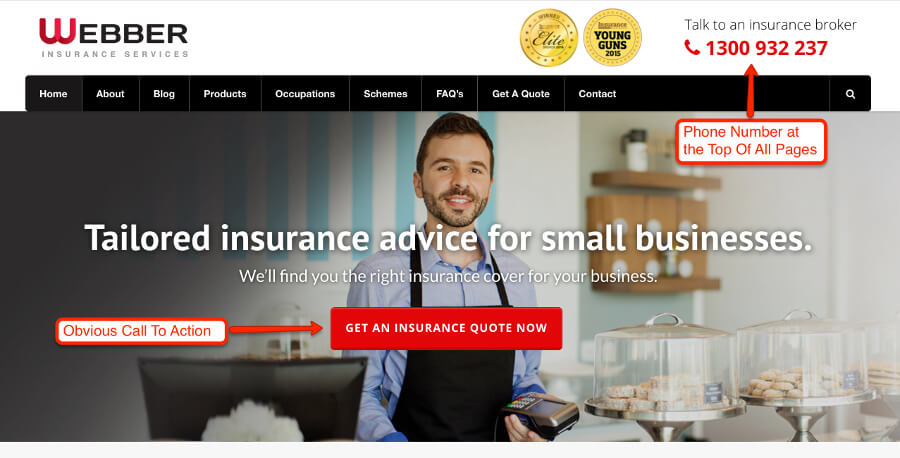
It’s great to drive traffic to your website, but if traffic doesn’t convert into prospects or sales, then you’re wasting your time.
It’s really simple – make it as easy as possible for your prospects to call, email, enquire and engage with you.
Ask yourself the following questions:
- Is your contact number highly visible?
- Are there contact forms on most (or all) pages?
- Do you have testimonials on your website? Testimonials with logos or photographs are more believable and credible.
- Have you considered adding a Trust Seal to your website?
- Do you use power words when describing your offers?
- What is your unique selling proposition (USP)?
ACTION STEP: Add calls to action and lead generation forms to your website.
10. Build An Email List

Email marketing is not dead!
In fact, email is still by far the best channel for blog promotion.
Email can be extremely effective in connecting with your customers and can generate more direct conversions than social media.
It’s a personal, one-to-one and value exchange for local businesses – and could be your secret weapon for generating more prospects.
Benefits include:
- Cost-effective way of promotion
- Builds relationships
- Higher engagement means high conversion rates
- Gently reminds prospects of your service
Make sure that you are delivery quality, relevant and interesting content.
Consider your tone and avoid emailing too frequently (no one likes a spammer). Focus on value exchange and what you can offer.
Use Leadpages to create opt in boxes to help grow your list.
ACTION STEP: Sign up to Mailchimp and load in your customers email addresses, and then add an ‘opt in’ box on your website.
11. Develop a Better Unique Selling Proposition (USP)
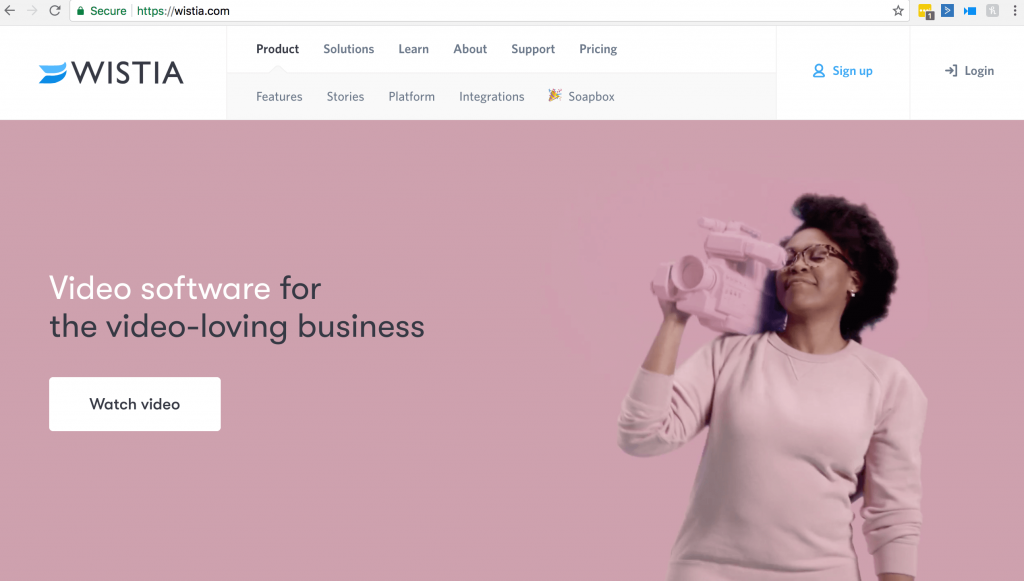
Your business needs a unique selling proposition (USP) – something that ensures your business, products and services stand out from your competition.
In many cases, potential prospects won’t know who you or your business is, and may not trust all the information featured on your website.
So what is it that makes you stand out from your local competitors?
What are some of the benefits to choosing you?
Use these to form your website’s USP.
ACTION STEP: Work out how you can differentiate your website, and feature it prominently.
12. Promote Your Phone Number And Email Everywhere
Place your phone number and email address (and business address where possible) into your header, footer and sidebar.
Make it as easy as possible for your prospects and customers to contact you.
Also be sure to wrap this business information as ‘structured data‘ so it is easier for search engines to find and interpret it as important contact details.
ACTION STEP: Add your phone number and contact information to your header and/or footer.
13. Only Use One Website (Avoid Microsites)
Having one primary website is going to be a lot better for your business in the long run for branding, consistency and logistically as it’s easier to manage content on one website rather than 4!
Avoid creating multiple microsites with duplicate content and similar names like:
- electrician-adelaide.com.au
- electrician-glenelg.com.au
- electrician-unley.com.au
If you are serving multiple locations, instead of creating a separate website for each area, just add an extra ‘service’ page to your primary website which outlines how you serve that area, and some of the products and services that you perform in that particular location.
Don’t forget to set up a new Google business page for each location and link them to that local service page (instead of your homepage).
ACTION STEP: Don’t create microsites (unless you have to).
14. Add Keywords Into Your Website
This seems to be pretty obvious, but is often overlooked.
Doing some local keyword research can reveal some great words that your customers are typing into Google that you might not have thought of previously.
Be sure do add your money keywords into your page titles, meta descriptions, headlines and within the body your website content as well.
Use variations (don’t stuff the same keyword in over and over) including synonyms, plurals, and modifiers such as ‘how much’, ‘price’, ‘cost’, ‘best’, throughout your content.
This will help your website rank for longer tail keywords, which can often bring in extremely qualified and motivated buyers.
ACTION STEP: Add you target keywords and variations into you page titles, sub headers and body content.
15. Include Testimonials and Case Studies
Credibility is everything.
Demonstrate to your visitors and prospects why they should trust you, and what they can expect when they purchase your services.
The Conversion Rate Experts use case studies and testimonials masterfully throughout their website. Take a look at how they feature the logos of their clients, along with what they say about the company.
Do they look like a company you can trust? Absolutely!
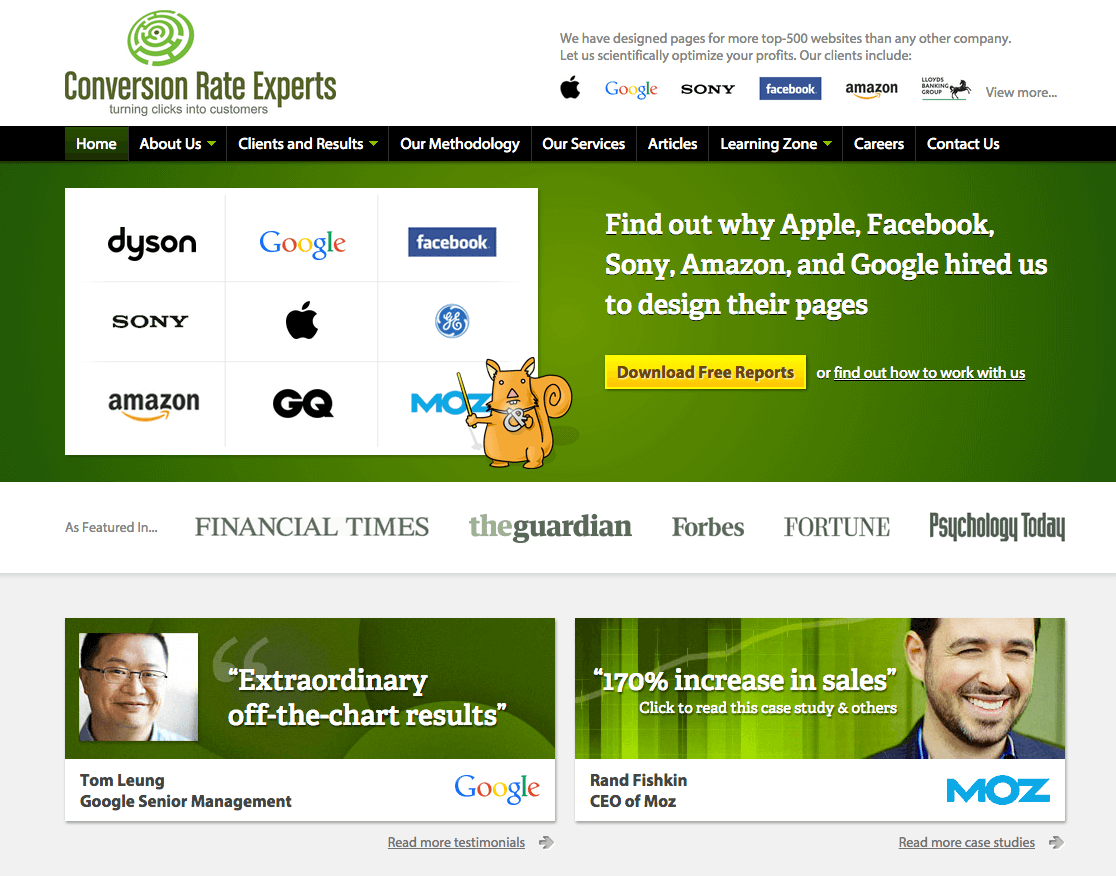
ACTION STEP: Get client testimonials and case studies and feature them on your site.
16. Include a Separate Page for Each Product/Service You Offer
This is so simple, but is often overlooked.
Write down a list of the services and products you offer in a Word document, then group the similar ones together.
Then create a separate page for each item on the list, on your website.
Write a summary of each service around 300-400 words in length, and include images, FAQ’s, videos and other relevant information that might be useful for your prospects.
Create a ‘services’ or ‘what we do’ tab in your navigation menu, and link to each of the pages you have just created.
You will now have a much greater chance to rank for that particular service, in your targeted location.
Don’t forget to include your target keywords and geographical location into your page title and throughout the body content.
ACTION STEP: Create a separate page for each of your product and service offerings.
17. Check Your Web Analytics
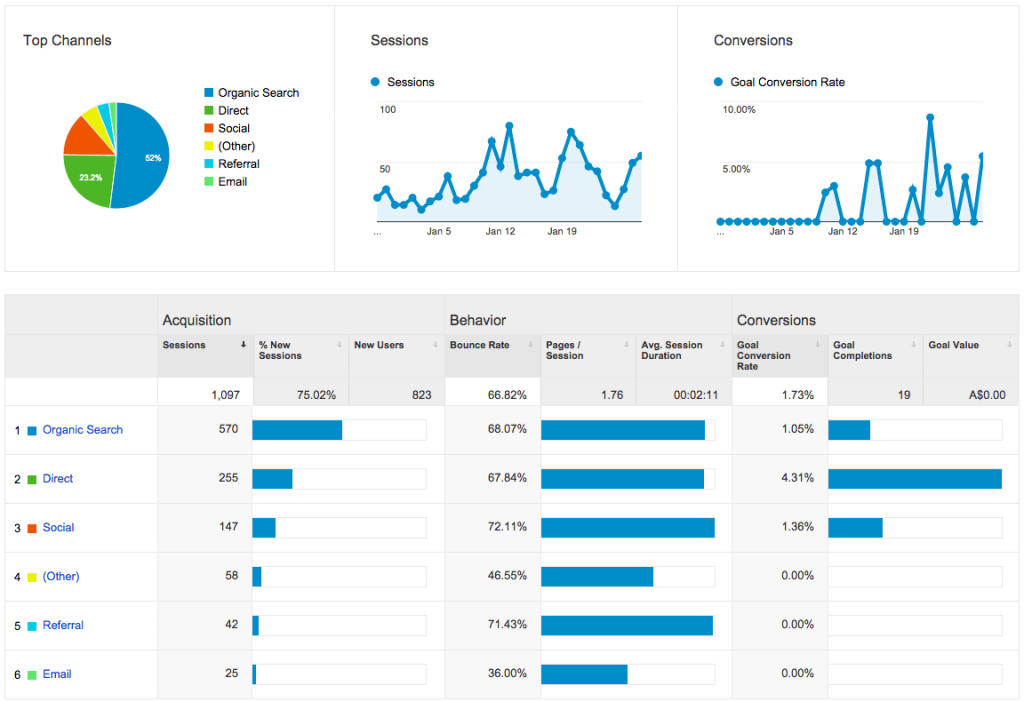
If you don’t have Google Analytics running on your website, then you are flying blind.
You need to know how, where and why prospects are coming to your website, and then what they are doing when they get there.
Analysing your website traffic can reveal new ideas for content to produce on the website, find out why visitors aren’t converting into a lead, and determine whether there are any technical issues that might be holding you back.
Without analytics, you can’t see any of this data or make educated decisions about your marketing tactics (or see the results of any marketing campaign you might be running).
ACTION STEP: Install Google Analytics and set up goal tracking and dashboards.
Your Local Website Can Rank on the First Page Too…
…but you need to take action on all 17 of the strategies mentioned in this post.
Fortunately, we’ve created a bonus downloadable checklist which makes implementing these 17 strategies a breeze.
Your Local SEO Rankings[/minti_headline][minti_headline type=”div” size=”fontsize-m” color=”#ffffff” weight=”fontweight-300″ lineheight=”lh-12″ align=”align-left” margin=”0 0 0px 0″]Click here to download to a free bonus checklist that will show you how to get your local business onto the first page.[/minti_headline]
